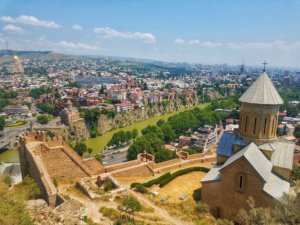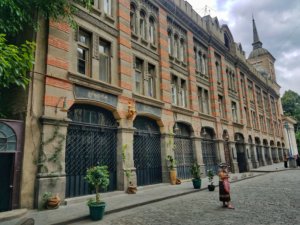Tbilisi is the capital of Georgia (the country), a tiny place most people know little, if anything, about. When plotting the location – Georgia is sandwiched between Russia and Turkey on the eastern Black Sea and is a stone’s throw from Iran and Iraq – many naive travelers instantly write it off due to unwarranted fears.

Nestled in the Southern Caucasus mountains, Georgia has withstood a long and tumultuous history and preserved its inimitable culture. A little bit Europe and a little bit Asia yields a destination that should be on every travel list.
Old Tbilisi is one of the hottest rising destinations for travelers in recent years. Despite tensions with Russia over conflicts in Abkhazia and South Ossetia, the city is peaceful, stable and extremely safe. Always travel aware, but there is no need to travel in fear in Georgia. Here are five great reasons to visit Tbilisi:
Fresh Bread in Old Tbilisi
A fresh baguette in Paris. Naan straight from the tandoor in India. There are certain places that have world-renowned bread. These foods have been romanticized by poets and foodies and crowned with the highest distinction. The rising of the kings has been proclaimed prematurely, with Georgian bread left out.
Bread in Georgia deserves to be known and loved around the world. The culture of food in Tbilisi and nationwide is centered around bread. The moment you sit down at a restaurant, your waiter will ask, ”Do you want bread?” The answer is yes.

Most neighborhoods have at least one tone bakery where locals and restaurant owners go for their daily fill. A tone bakery is a Georgian-style bakery with tone ovens, large pots that are partially underground and heated to very high temperatures. Like the tandoor, the bread is stuck to the inner sides of the tone until it is cooked, which does not take long.

Shoti and tonis are the most common types found. Basically, they’re funny-shaped large breads that go well with anything from soup to beer. They’re also a great snack for day-trips or travel days.
Old Tbilisi has a shortage of bakeries, placing a higher focus on tourist cafes, restaurants and hotels. But there is one! Directly across from Sioni Cathedral is a bakery known by the internet as “Bakery near Seminary.” If there is another name, the sign is in Georgian, and it remains a mystery here. All you need to know is that you can find this bakery by going to Sioni and looking across the (walking) street. Follow the smell and go down the stairs. Sounds creepy, but it’s delicious.


Prices are comparable to bakeries in Baku, Azerbaijan. For about 1 Georgian lari (GEL), you can get fresh baked bread bigger than your head. That’s less than $0.50 USD.
When going out for your bread fix in Tbilisi, don’t worry about arriving too early. Georgians aren’t keen on early mornings and the bakery should be able to fulfill your needs any time before noon. Finding a place for an 8 or 9 AM breakfast will be a challenge, so be patient or head to the bakery.
Churches
Georgia is a very religious country and overwhelmingly adheres to Georgian Orthodox Christianity. One of the oldest Christian nations in the world – southern neighbor, Armenia, is the oldest – the Georgian Orthodox Church is more than a religion in the country. It is an instrumental part of daily life for Georgian people.
The Church is represented clearly across Tbilisi and is literally placed in high regard by the people. The capital city is filled with churches and monasteries, some ancient and others built after independence from the Soviet Union. It would be a difficult task to wander Tbilisi and not come across multiple churches.
Sioni Cathedral of Tbilisi is an ancient church dating back to the 500s AD. It is located in Old Tbilisi and any visitor to the city will inevitably pass the small, stone building. It is the historical center of the Georgian Orthodox Church and is as much a functioning church as it is tourist attraction. Like many Orthodox churches, inside Sioni is dark and eerie with icons glowing from the cornucopia of candlelight.

The Holy Trinity Cathedral is on the east (right) bank of the Mtkvari (Kura) River which separates the city of Tbilisi. It is the center of the Georgian Orthodox Church and provides a great opportunity exploring another part of the city. Head over the Metekhi bridge and you have a good view across the river to Old Tbilisi and Narikala fortress. Winding your way through the neighborhood towards Holy Trinity, you will see a few more churches along the way. You may also notice that just a few blocks east of the river, the number of tourists drops substantially.
The Holy Trinity Cathedral, visible all across Tbilisi, is a newer church built in the 21st century. The city and national symbol is about a 30 minute walk from Old Tbilisi. Inside the cathedral feels like the belly of a mountain, with every movement echoing and amplified for all to hear.

Other churches worth a visit include the riverside Metekhi (across the Metekhi Bridge, on the way to Holy Trinity Cathedral), with a giant equestrian statue, and Kashveti, which provides an interesting contrast situated on a busy, modern street.

Orthodox churches have strict dress codes. Shorts and tank tops are not allowed, and women usually need to wear a headscarf. You should come dressed appropriately, but many of the busier churches have a bin of clothing for use during your visit. Other rules for are simple: if it says no pictures, that means put your camera down. Be respectful. Be quiet.
Visiting Tbilisi’s churches is a good idea for several reasons. The brief immersion in quiet reverence and stunning architecture of the Georgian Orthodox culture, in order to better grasp the reality of religious struggles in the not-so-distant past, will help to explain Tbilisi for what it has become today. As always, a well-informed traveler is a well-prepared traveler.
Khinkali
Khinkali is Georgia’s edible gift to the world. If for no other reason, Tbilisi is worth the trip for this pudgy little bag of pleasure. Any time spent in the city should dedicate at least a few feedings to this staple of Georgian cuisine.

Khinkali is a boiled dumpling that traces its origin to rural, rugged Georgia. These dumplings look like upside down chef’s hats and are traditionally filled with pork, beef, lamb or a combination. There are also vegetarian versions filled with potatoes, cheese or mushrooms.
The magic that is Khinkali comes in its preparation. The meat inside the dumpling is raw before boiling, finishing as a doughy bag of meat and broth. Eaten properly, you grab the dumpling by the twisted end and suck the broth out of the bottom. Khinkali is like a hearty soup inside a bag of dough.

Traditionally a winter food, you can eat this dumpling anytime, especially in the center of Tbilisi. Although many of the restaurants in the center of town are more expensive or geared towards tourists, you can still get a plate-full of khinkali (about six) for 10 GEL, about $3-4 USD, in many restaurants. The same amount goes for four to five times that rate in restaurants in the United States
Narikala Fortress
Narikala Fortress has been overlooking Tbilisi in some form since the 4th century. The state and appearance of the fortress has varied through history depending on its occupiers. Today’s fortress, hundreds of years old, is partially in ruins from those occupiers and the wrath of Mother Nature.
Narikala is visible from almost everywhere in Tbilisi, sitting above the city during the day and glowing at night. The fun in visiting the fortress is climbing the crumbling walls, taking in the best view of Tbilisi and photographing a scene like nowhere else.

Finding the best vantage point should be on every list when visiting a new city. This often means going up to the top of some heavily-touristed landmark. But just as the Space Needle in Seattle or the Eiffel Tower in Paris are part of the typical tourist schedule, sometimes touristy activities are worth the wait and price of a visit.
The best part about Narikala fortress is that there is no entrance fee. Free attractions are the best reasons to visit any place. All you have to do is walk up the hill and enjoy the view.
Dry Bridge Flea Market
The Dry Bridge, an old, stone bridge arching its way across the Mtkvari, sits about one mile north of the epicenter of Old Tbilisi. Here, on the left (west) bank of the river sits Dedaena Park. The park straddles a busy road, but your interest lies in the north section of the park where you will find a flea market unlike any you’ve seen in Western Europe or the United States.


Remember to bargain! A lot of the goods for sale are cheap, but that doesn’t mean the prices are fair. Unless you’re an expert, you never know with certainty if you’re buying something authentic or replica. Every seller is willing to negotiate and this adds to the fun in any market.
The Dry Bridge Flea Market makes its way through most of the entire northern section of the park. Like many markets, you can find rugs, artwork, and handmade crafts. The fun of this flea market is that it’s in a former Soviet Republic.

Georgia’s alluring history is well-represented in the curiosities for sale. Soviet-era goods are on full display. For history lovers, the Soviet relics are plenty. War medals, propaganda posters and pins, military garb and coins (guilty here – I have a fascination with coins) are at every turn.

Symbolic Georgian replicas like drinking horns and clay wine pots are presented en masse for tourist keepsakes. A good note is that many of these souvenirs are available in the shops in Old Tbilisi, but you will find them cheaper at the flea market. And you can bargain!

Flea markets are a lot of fun for many types of people, and the Dry Bridge flea market is no exception. Another reason to visit Tbilisi, there is something for every traveler and you should dedicate at least one or two sessions to perusing the wares and trinkets at this must-see market.
Old Tbilisi, Georgia
These five reasons are just a few of the reasons to visit Old Tbilisi and explore the fantastic surrounding city. The best bread and pastries in the world, stunning architecture, postcard-pretty cobblestone streets and great wine are just the beginning. The Caucasus, as a whole, is one of the most underrated and overlooked travel destinations in the world. Georgia, especially, is an exceptional country with exceptional people.
This place has everything to look for in a great travel destination. Travelers are catching on to the region and returning for more. Old Tbilisi, Georgia absolutely deserves a spot on every travel list!
Updated: 4/26/2019
Leave a Reply
You must be logged in to post a comment.